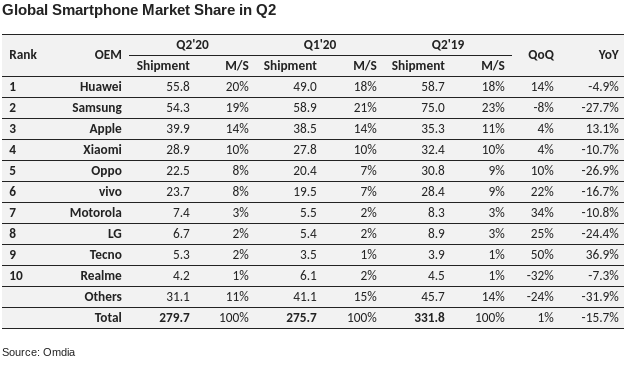Due to COVID-19, the Q2 2020 smartphone market was a bit like the walking half-dead: a zombie of livelier past years.
The 2020 global pandemic is impacting the worldwide smartphone market in a big way. Even as some countries have begun to loosen restrictions, others are still dealing with the initial COVID-19 wave. For smartphone OEMs, this means that the second quarter or Q2 2020 smartphone market was yet another with extraordinarily frightening circumstances — and quickly changing realities.
The result of this is a 15.7 percent decline in shipped smartphones year-over-year — declining from 331.8 million units in the second quarter of 2019 to 279.7 million in the second quarter of 2020. However, the pandemic has shifted consumers’ preference from high-end, expensive phones to more affordable but still top-quality phones or brands. For instance, Vivo Philippines now has a higher demand, with more millennials purchasing their products.
There are good reasons to invest in the latest phone brands like Vivo phones. These include innovative designs, high-end features at very competitive prices, and excellent customer service.
For most original equipment manufacturers or OEMs, the second quarter was another of negative growth. Of the major OEMs, Apple was most successful in navigating the marketplace. The company expanded shipments by 13.1 percent on the back of its iPhone 11 and iPhone SE products.
Huawei beats Samsung for the first time
Shipping 55.8 million units in the second quarter of 2020, Huawei surpassed Samsung for the first time. Samsung shipped 54.3 million units during the quarter for the first time. Because of the recovery in China, Huawei’s shipments declined by only 4.9 percent compared to the 58.7 million units the company shipped in the second quarter of 2019.
Despite facing continued sanctions from the US government, now going into their second year, Huawei has been able to mitigate impacts on its international business enough to compete with Samsung and finally claim the global top spot.
Samsung, on the other hand, saw shipments decline by 27.7 percent year-over-year (YoY), from 75 million units in the second quarter of 2019 to 54.3 million units in the second quarter of 2020. Many of Samsung’s most important markets were significantly impacted by COVID-19, especially emerging markets which accounted for more than 70 percent of Samsung’s overall shipment in 2019.
China is not a large-scale market for Samsung, so the company cannot benefit from the recovery there. In Western Europe, reopening and loosening of restrictions started near the end of the quarter, meaning that much of the first and second quarters were impacted for many of Samsung’s key markets.
For the longest time, Apple and Samsung took the top rank in the most-sold and in-demand smartphones in the market. But with the pandemic, more people are realizing that instead of splurging on expensive phones, they can instead opt for more affordable but high-quality phones like those from Huawei.
Apple’s product mix helps in Q2
Only Apple, iTel, Tecno and Infinix attained positive shipment numbers in the second quarter of 2020, compared to the second quarter of 2019. Apple shipped 39.9 million units, up 13.1 percent from 35.3 million units last year. The iPhone SE, a model with mid-range pricing, and the iPhone 11 helped Apple expand its unit shipments.
“With the launch of the iPhone SE in April, Apple has released a long-desired product, with an attractive price,” said Jusy Hong, director of smartphone research at Omdia. “A $399 starting price point makes the iPhone SE an attractive new device, especially in the face of continued economic uncertainty in many markets. For existing iPhone users who needed to upgrade their smartphones in the second quarter, the new SE represented an affordable option that does not require a large down payment or high monthly repayment rates.”
Q2 2020 global smartphone market chart

Regional focus aids Transsion Holdings
The other brands with positive shipments are all part of Transsion Holdings: iTel, Tecno and Infinix. The brands recorded shipment growth of 35.3 percent, 36.9 percent and 17.3 percent respectively, year-over-year (YoY). Transsion Holdings shipped 12.0 million units million units in the second quarter, up from 9.1 million units in the second quarter of 2019.
All three brands focus on the Middle East and Africa as their main target markets. Because of Huawei’s weakening presence in the market, and the return of production in China at the end of the first quarter of 2020, these three brands were less affected by the pandemic than other brands.
A challenging market for most OEMs
In the first quarter of 2020, Realme was one of the few OEMs whose growth was spurred by resiliency in the Indian market. Now, however, Realme has joined all other OEMs in facing declining shipments in the second quarter. Realme’s shipments declined 7.3 percent YoY, to 4.2 million units from 4.5 million units last year.
Tensions between the Indian and Chinese governments have impacted the smartphone market in India, even though many Chinese OEMs have invested significantly over the last 18 months to increase their production and customer service operations in the country. For OEMs like Realme, vivo and Xiaomi, which focus on this market, the pandemic and governmental issues contribute to a difficult second quarter of 2020.
Vivo saw shipments decline 16.7 percent, from 28.4 million units in the second quarter of 2019 to 23.7 million units in the past quarter. OPPO saw an even larger decline, of 26.9 percent YoY, shipping 22.5 million units compared to 30.8 million units last year. Xiaomi’s shipments, on the other hand, declined 10.7 percent YoY to 28.9 million units.
In the Philippines, Vivo Philippines, one of the latest phone brands, is still positive. A big reason for this is that it targets millennials and younger generations by highlighting Vivo technology, which is focused on taking selfies. The company also has 5G-ready innovations through the sophisticated gaming features of their smartphones, such as the Vivo V-19 Neo. Also, the company offers a warranty extension while the country is still in strict quarantine.
The rest of the Top 10 global OEMs all saw shipments decline. LG shipped 24.4 percent fewer smartphones, at 6.7 million units, than last year’s 8.9 million units. The company continues to struggle against mid-range competition from Chinese OEMs in many markets.
Motorola had another quarter of 10.8 percent YoY shipment decline. In the second quarter of 2020, Motorola shipped 7.4 million units compared to 8.3 million units in the second quarter of 2019. The pandemic has impacted the launch of relaunch of the new RAZR, the company’s first foldable device, and is making it difficult for Motorola to break through a difficult market with its latest devices. The COVID-19 crisis is occurring just as the company was set to return to unit and market share expansion.
Ongoing challenges
Although many countries have lifted some restrictions on movement and business activities, and others are working towards a return to normal, other countries still continue to be in the midst of the initial outbreak. There are also signs of potential new outbreaks in countries where the virus has been brought under control.
In this continued environment of uncertainty, the smartphone market will continue to be impacted in third and fourth quarters of 2020. While smartphone OEMs have found their footing in terms of releasing new devices and continuing on the path of their product roadmaps, user purchasing behavior will continue to depend on the strides made in fighting the outbreak and containment of the subsequent threat of new outbreaks.
Smartphone brands battle
Giant smartphone manufacturers are in a heated battlefield. With the latest trends and innovations, each company has something to offer. A sophisticated feature of one company is easily modified or enhanced by another company, leaving consumers plenty of options to choose from.
But do consumers really need all those bells and whistles from the latest smartphones? Gadget fanatics and high-income earners would probably want to invest in the latest smartphones. However, with the pandemic, many people prefer to invest in a smartphone with the best features at an affordable price, such as Vivo and Huawei.
For more info:
For the full report or to join Omdia’s over 14,000 subscribers, head to omdia.com. Now a research powerhouse, Omdia was established following the merger of the research division of Informa Tech (Ovum, Heavy Reading and Tractica) and the acquired IHS Markit technology research portfolio.





